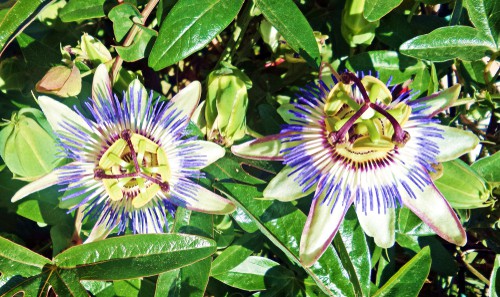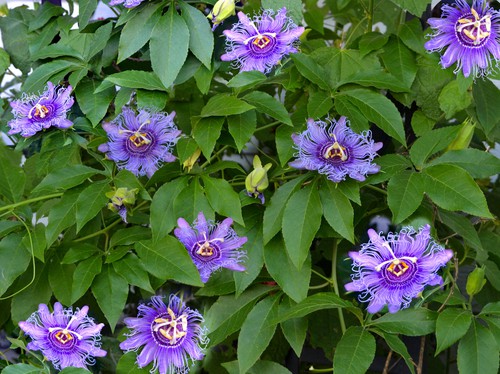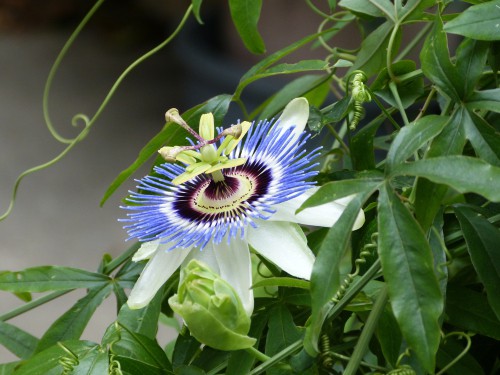Last updated on March 21st, 2022
Our site is reader supported, this means we may earn a small commission from Amazon and other affiliates when you buy through links on our site.
Passion flowers are evergreen climbers that are self-clinging by nature and will crawl their way up any surface you allow. They offer some of the most beautiful and unique flowers that leave behind the tropical fruit, passionfruit. The most popular variety is Passiflora caerulea which is hardy in most parts of the UK although it does need a sheltered spot. The fruits are edible, however, be warned, they must be fully ripe or it can cause stomach upset, underripe fruit is usually yellow.
As passion flowers seem to grow better when their roots are restricted, this makes them perfect for growing in containers and pots where this can easily be achieved.
Choosing a Pot for Passion flowers
As mentioned, Passion flowers do best when their roots are constricted so growing them in containers is a great way to do this naturally. The containers should be a little larger than current root ball but in general, a good size pot is better, something around 30-50cm wide depending on how big the root ball is when you purchase the plant.

In terms of material, it’s important to pick one that is well-draining. Plastic containers are perfectly fine as long as they are durable enough to not get knocked over and they are easier to drill additional holes in if necessary. Glazed pots seem to work well, as do terracotta pots.
What Compost to Use and Planting
Choosing the right pot and compost
The compost you should use should be a very good quality peat-free compost. We recommend getting a John Innes No 3 potting compost and mixing in some grit to improve drainage. It’s also worth putting a layer of grit on the surface of the soil to help retain moisture, plus it helps deter slugs too.
Planting in containers
When it comes to planting, plant at the same depth as it was in its original pot so that the top of the root ball is just below the surface by a few millimetres and water well. It’s also worth soaking the root ball for 30 minutes before planting, especially if it’s dry.
Where to position a Passion flower
Place in a sheltered position in full sun or partial shade
It is best to position the containers in an area where they get full sun or dappled shade and where they are protected from cold, drying winds. If you have a wall that faces south or west, or any combination of those two, it’s the best location for your plants, and they should thrive well and have adequate shelter. If you are growing one of the more tender varieties such as Passiflora × exoniensis in your greenhouse or your conservatory just make sure that the leaves have protection against direct sunlight so they don’t get burned.

Feeding and Watering
When your container-grown passion flowers are in the middle of their growing season you should water them freely so that they don’t dry out, they prefer to have moist soil and when grown in pots they will need watering more often, sometimes daily in times of warm weather during the summer. Come winter you can water them more sparingly until the point that the compost surface of your container starts to dry out.
Feed with a multipurpose feed such as growmore during the growing season
These plants are prolific growers. You don’t need to feed them regularly in many cases because it will lead to excess growth and reduced flower production. However, if your plant is particularly weak you can add a general fertiliser (such as growmore) to give them a boost. This is best done from spring when they can make use of the extra nutrients.
Pruning Potted Passion flowers
With pot grown passion flowers, it is best to place the containers against a wall, fence, or another surface up which the plant can climb. You can choose to let it climb at will, however, it will grow very quickly and soon take over any other area you have, so pruning is generally done to keep the growth within a given framework.

It will do better if you use fan training, a method of cutting back any of the trailing tips to encourage the plant to branch out from the main framework. It is recommended that you tie down the main shoots in a horizontal fashion so that all of the flowering shoots start to hang down.
Once your plant is established, you can use the spring season to shorten any overgrown shoots or remove anything that was damaged by the frost. Do this annually to keep the passion flower confined to a certain area, this will also prevent the plant from becoming overgrown and in need of a hard pruning. If the plant is overgrown or damaged, you can carry out heavy pruning in spring by cutting it back to just about 60cm (2ft) from the soil.



1 Comment
If i wrap my potted passi in bubble wrap and store it in the shed through winter.do i ever need to water it during the winter period